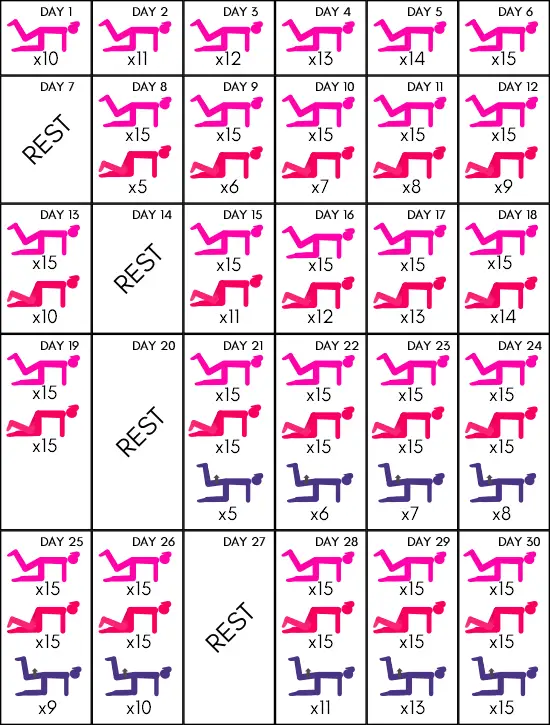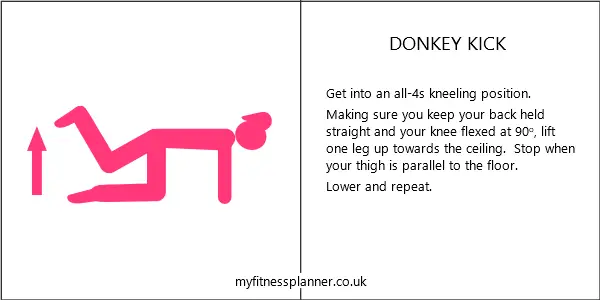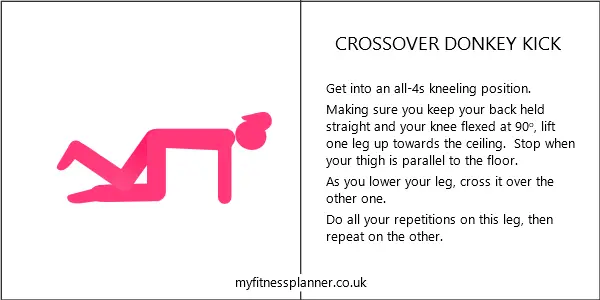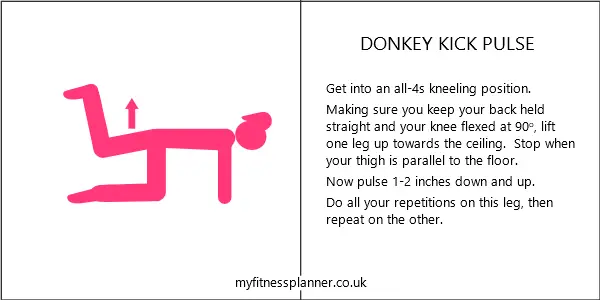Donkey kicks are one of the best exercises for focusing on the largest glute muscle (gluteus maximus), which is the one that shapes and lifts the butt. Looking better isn’t the only advantage to training the glute max though. Strong glutes are important for good posture, back care and sport and fitness performance. Other benefits of the donkey kick exercise are:
- Improves core stability: the exercise requires you to engage your core muscles to maintain stability while lifting your leg. This helps to improve core strength and stability.
- Improves hip mobility: donkey kicks involve hip extension, which helps to increase hip mobility and range of motion. This can be beneficial for activities that require a lot of hip movement, such as running, jumping, and squatting.
- Can be done anywhere: donkey kicks require no equipment and can be done anywhere, making them a convenient exercise to include in your routine.
Why working the glute max is important
Humans have a more developed glute max than other animals, because it plays a major part in keeping us standing upright. This means that when it becomes weak (which it often does due to inactive lifestyles and sitting too much), posture problems develop. Weak glutes are usually accompanied by tight hamstrings, tight hip flexors, weak abs and low back problems. Unfortunately, weak glutes are hard to target because they tend to “switch off” and allow other muscles to do the work. When this happens you need to do exercises that focus specifically on the glutes – often referred to as glute activation or glute isolation exercises. Donkey kicks are ideal for isolating the glute max.
The glute max also performs the action of hip extension – taking the leg behind the body. This action is important to walking and running. Although we move forwards in these activities, as we step forward on one leg, the other leg swings back, ready to take the next step. The more powerfully it can swing back, the more powerful the forward stride.
About this workout
You’ll need some cushioning for your knees – ideally an exercise mat. See an exercise mat buying guide here.
Please read these general exercise guidelines before you do the challenge
Donkey kicks challenge – exercise chart
There are 3 variations on the donkey kick in this challenge:
- Standard donkey kicks (shown in pink)
- Crossover donkey kicks (shown in red)
- Donkey kick pulses (shown in blue)
Instructions for the exercises are below the chart.
The number shown is for each leg. Where there is more than one exercise, do all reps on one side and then change.

Exercise instructions



Related to donkey kicks challenge
Challenge FAQs
The first day of the challenge should feel like it needs a bit of effort, but not too much. If you really struggle with day 1, then you probably won’t get through the challenge. The idea with the challenges on this site is that the first few days get you used to the exercises and the daily habit. Usually about halfway through the challenge the effort levels start to increase more quickly.
Avoid challenges that increase effort levels very quickly – they’re simply not realistic. It’s unlikely that, for example, you would be able to increase how many squats you are able to do by 10 a day for 30 days, or increase your plank hold time by 10 seconds a day for 30 days.
In general, allowing muscles 48 hours between workouts is good because it gives our bodies time to recover and adapt. Challenges are generally short workouts and for a limited period of time (usually 30 days), so not having many rest days won’t be a problem. With challenges that alternate exercises each day, it’s not an issue, because you’re using different muscles.
Fitness improvements don’t always happen in a predictable way. Sometimes we’re just not as strong or energetic for no apparent reason, or we hit a plateau. If you get to a point where you’re struggling to complete the day’s challenge, you can try one of the following:
- Take a couple of days off and start again where you left off
- Do the challenge on alternate days rather than every day
- Instead of increasing the effort every day, stay at the same level for 2 or 3 days and then go onto the next day of the challenge
Obviously these solutions mean the challenge will last longer, but you’ll still benefit from doing it.

